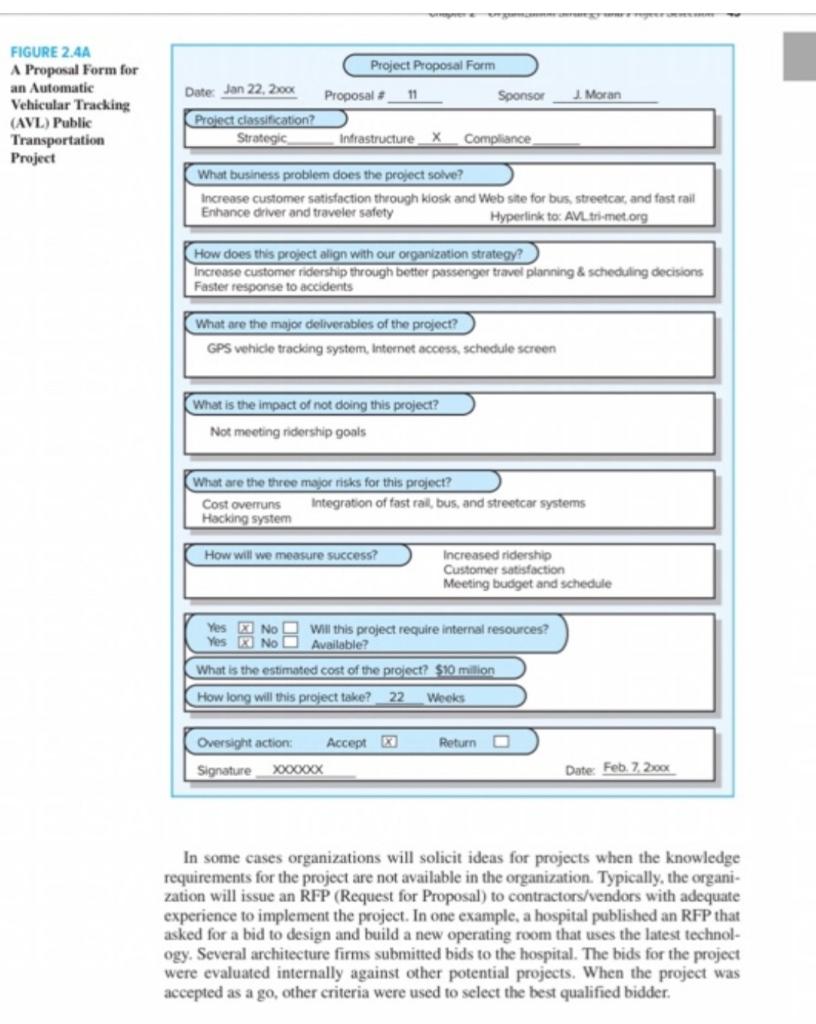- Project is about Manchester United Soccer Club
- Some examples to develop a web page for Manchester united soccer club , expand a current business operation, deploy a new product or service offering, etc.
- At a minimum, the forms shown in Figure 2.4A and Figure 2.4B need to be used for proposal.
- Proposal templates or form added to this assignment.
- Identify the project management lifecycle and determine how this lifecycle process affects the organization that would be most relevant to the selected project. (c. 1.6) Assume that this proposal would eventually be expanded into a full project.


Project Proposal Form Date Jan 22, 200x Proposal 11 Sponsor Moran FIGURE 2.4A A Proposal Form for an Automatic Vehicular Tracking (AVL) Public Transportation Project Project classification? Strategic Infrastructure X Compliance What business problem does the project solve? Increase customer satisfaction through kiosk and Web site for bus, streetcar and fast rail Enhance driver and traveler safety Hyperlink to: AVL tri-met.org How does this project align with our organization strategy? Increase customer ridership through better passenger travel planning & scheduling decisions Faster response to accidents What are the major deliverables of the project? GPS vehicle tracking system Internet access, schedule screen What is the impact of not doing this project? Not meeting ridership goals What are the three major risks for this project? Cost overruns Integration of fast rail, bus, and streetcar systems Hacking system How will we measure success? Increased ridership Customer satisfaction Meeting budget and schedule Yes No Will this project require internal resources? Yes No Available? What is the estimated cost of the project? $10 million How long will this project take? 22 Weeks Return Oversight action: Accept Signature xoxx Date: Feb. 7. 2004 In some cases organizations will solicit ideas for projects when the knowledge requirements for the project are not available in the organization. Typically, the organi- zation will issue an RFP (Request for Proposal) to contractors/vendors with adequate experience to implement the project. In one example, a hospital published an RFP that asked for a bid to design and build a new operating room that uses the latest technol- ogy. Several architecture firms submitted bids to the hospital. The bids for the project were evaluated internally against other potential projects. When the project was accepted as a go, other criteria were used to select the best qualified bidder. 46 Chapter 2 Organisation Strategy and Project Selection FIGURE 2.4B Risk Analysis for a 500-Acre Wind Farm Brief Risk Assessment Purpose: To draw attention to apparent project risks that will need management attention What are the four major risks of this project? 1 Government incentives curtoiled 2. Land use injunction 3. Energy price decrease 4 New import tax Rank risks above by probability and impact on the chart below by High Medium or Low. Risk Intensity Rating Impact Probability High Medium 1 Government incentives curtailed 2 Land use injunction 3. Energy price decrease 4. New import tax Medium Medium Low High Check other project risk factors: Complexity Low Resource skills Good x Technology Low Average x Ladang DOD Average x Reviewed by Rochel Date Art 200x Ranking Proposals and Selection of Projects Calling through so many proposals to identify those that add the most value requires a structured process. Figure 2.5 shows a flow chart of a screening process beginning with the creation of an idea for a project. See Figure 123 for a template for evaluating contractors Data and information are collected to assess the value of the proposed project to the organization and for future backup. If the sponsor decides to pursue the project on the basis of the collected data, it is forwarded to the project priority team (or the project office). Note that the sponsor knows which criteria will be used to accept or reject the project. Given the selection criteria and current portfolio of projects, the priority team rejects or accepts the project. If the project is accepted, the priority team sets imple mentation in motion Figure 2.6 is a partial example of an evaluation form used by a large company to pri- oritize and select new projects. The form distinguishes between must and want objec tives. If a project does not meet designated "must" objectives, it is not considered and is removed from consideration. Organization (or division) objectives have been ranked and weighted by their relative importance--for example, "Improve external customer ser- vice" carries a relative weight of 83 when compared to other want objectives. The want objectives are directly linked to objectives found in the strategic plan Project Proposal Form Date Jan 22, 200x Proposal 11 Sponsor Moran FIGURE 2.4A A Proposal Form for an Automatic Vehicular Tracking (AVL) Public Transportation Project Project classification? Strategic Infrastructure X Compliance What business problem does the project solve? Increase customer satisfaction through kiosk and Web site for bus, streetcar and fast rail Enhance driver and traveler safety Hyperlink to: AVL tri-met.org How does this project align with our organization strategy? Increase customer ridership through better passenger travel planning & scheduling decisions Faster response to accidents What are the major deliverables of the project? GPS vehicle tracking system Internet access, schedule screen What is the impact of not doing this project? Not meeting ridership goals What are the three major risks for this project? Cost overruns Integration of fast rail, bus, and streetcar systems Hacking system How will we measure success? Increased ridership Customer satisfaction Meeting budget and schedule Yes No Will this project require internal resources? Yes No Available? What is the estimated cost of the project? $10 million How long will this project take? 22 Weeks Return Oversight action: Accept Signature xoxx Date: Feb. 7. 2004 In some cases organizations will solicit ideas for projects when the knowledge requirements for the project are not available in the organization. Typically, the organi- zation will issue an RFP (Request for Proposal) to contractors/vendors with adequate experience to implement the project. In one example, a hospital published an RFP that asked for a bid to design and build a new operating room that uses the latest technol- ogy. Several architecture firms submitted bids to the hospital. The bids for the project were evaluated internally against other potential projects. When the project was accepted as a go, other criteria were used to select the best qualified bidder. 46 Chapter 2 Organisation Strategy and Project Selection FIGURE 2.4B Risk Analysis for a 500-Acre Wind Farm Brief Risk Assessment Purpose: To draw attention to apparent project risks that will need management attention What are the four major risks of this project? 1 Government incentives curtoiled 2. Land use injunction 3. Energy price decrease 4 New import tax Rank risks above by probability and impact on the chart below by High Medium or Low. Risk Intensity Rating Impact Probability High Medium 1 Government incentives curtailed 2 Land use injunction 3. Energy price decrease 4. New import tax Medium Medium Low High Check other project risk factors: Complexity Low Resource skills Good x Technology Low Average x Ladang DOD Average x Reviewed by Rochel Date Art 200x Ranking Proposals and Selection of Projects Calling through so many proposals to identify those that add the most value requires a structured process. Figure 2.5 shows a flow chart of a screening process beginning with the creation of an idea for a project. See Figure 123 for a template for evaluating contractors Data and information are collected to assess the value of the proposed project to the organization and for future backup. If the sponsor decides to pursue the project on the basis of the collected data, it is forwarded to the project priority team (or the project office). Note that the sponsor knows which criteria will be used to accept or reject the project. Given the selection criteria and current portfolio of projects, the priority team rejects or accepts the project. If the project is accepted, the priority team sets imple mentation in motion Figure 2.6 is a partial example of an evaluation form used by a large company to pri- oritize and select new projects. The form distinguishes between must and want objec tives. If a project does not meet designated "must" objectives, it is not considered and is removed from consideration. Organization (or division) objectives have been ranked and weighted by their relative importance--for example, "Improve external customer ser- vice" carries a relative weight of 83 when compared to other want objectives. The want objectives are directly linked to objectives found in the strategic plan








